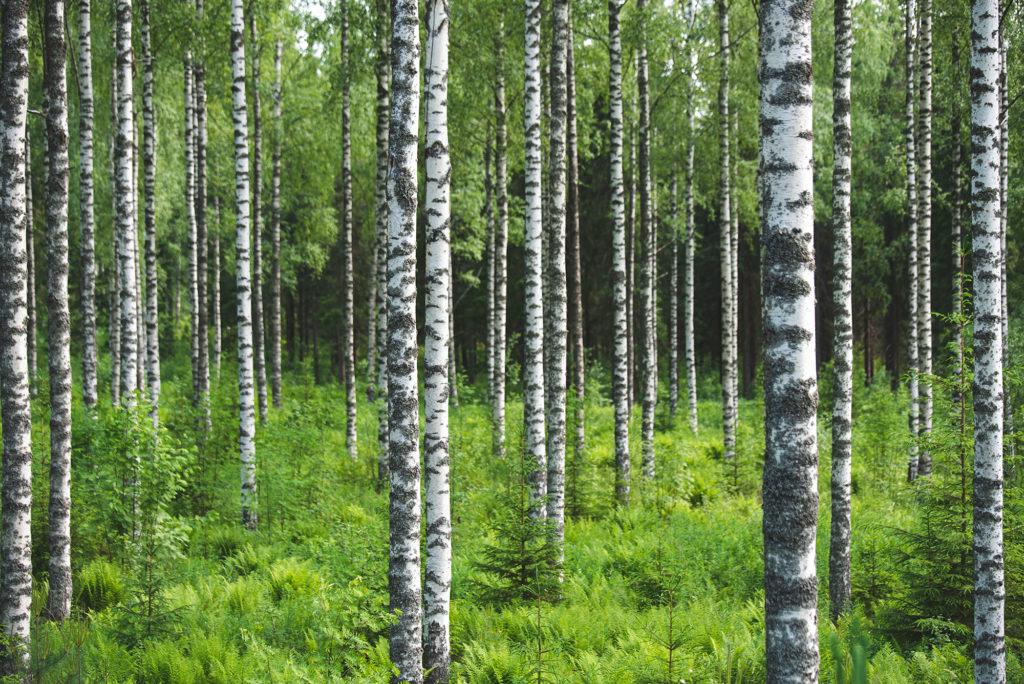Forest stands deserve expertise
With demand for birch plywood growing globally, both birch butts and birch logs are needed at Koskisen’s thin veneer plywood and plywood mill.
The branches of a high-quality birch stand begin as high up as possible. Dry branches and chaga mushrooms are a sign that a birch tree is not entirely healthy. This is why birch tree stands should be harvested early enough and special attention should be paid to their condition to ensure that they yield birch logs and butts, which are more valuable than pulpwood.
Koskisen – a popular buyer of wood
Recently, Sami Paakkunainen’s work as a purchasing supervisor has kept him on the move with frequent assessment visits to forests.
“It’s been busy,” admits Paakkunainen with a grin. “Koskisen is a well-known buyer of birch, even though we do procure other types of wood as well. We are a good buyer, cutter and user of birch. That is why forest owners are also happy to offer us smaller batches of birch. We’re able to pay a better price for birch butts if we can get them,” he adds.
Assessments of forest stands determine the sale value
Next up is one of the key stages of the wood procurement process: Paakkunainen visits the felling site. “It’s always worth showing up in person. The forest owner may be in for a positive surprise. There is usually more birch than we are first offered,” he says.
Paakkunainen, with a decade of experience under his belt, remembers an incident where a miscalculation turned out to be a happy accident: “We were offered an estimated 36 cubic metres of birch logs but it was actually 177 cubic metres when it was harvested. That is a huge leap in value.” According to him, the volume of birch can rise, on average, by 15–20 per cent. “It is rare for there to be less than estimated, but that has happened too, of course,” he points out.
Paakkunainen enjoys visiting felling sites and he has developed an eye for the job over the years. “It’s fascinating to see the offered stand on paper and then to see the actual forest. There’s no other way to learn this job except to head to the forest.”
It is important to inspect the goods onsite for other reasons as well. “I plan the harvesting in my head, for example, whether the timber trucks will be able to turn in the area.” Then Paakkunainen sets a price for the offered stand based on cost factors and current purchase agreements. “Which means the volume we are purchasing at the time,” he says.
Caring for birch stands pays off
According to Paakkunainen, birch stands are currently particularly interesting. Koskisen buys two types of birch logs: the birch butts go to the thin veneer plywood and plywood mill in Hirvensalmi where branchless butts that have a top diameter of at least 26 centimetres are processed. The Järvelä plywood mill uses as its raw material large crack-free birch logs. “The top diameter of logs like this must be at least 18 centimetres. A good trunk is healthy and has as few dry branches as possible. The quality of the tree is usually good if the branches begin high up,” Paakkunainen explains.
Birch trees growing in fields can have flaws resulting from the soil as birch trees grow faster in nutrient-rich soil and this can cause discoloration and cracking due to frost, making the birch wood unsuitable for plywood. “Wood like this can, of course, be used as pulpwood but we always pay more for logs than pulpwood.”
Paakkunainen gives forest owners a useful tip: birch stands should be harvested at a younger age than they are currently being offered to buyers. “Also keep tabs on the condition of the trees before it’s too late. Dry branches or chaga mushrooms on a tree are already a serious symptom. For example, a fir tree in the same stand may be perfectly healthy, while a birch tree may be rotting from its roots or crown. Birch logs may look healthy to the untrained eye, but once they’re cut they can only be used as pulpwood.”
